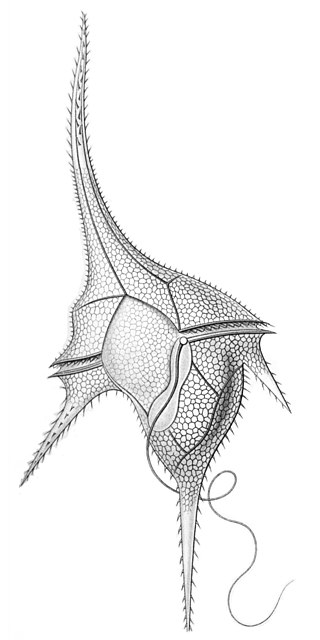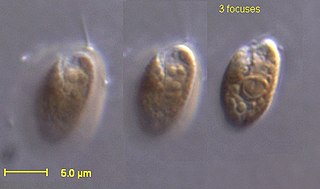
The dinoflagellates are a monophyletic group of single-celled eukaryotes constituting the phylum Dinoflagellata and are usually considered protists. Dinoflagellates are mostly marine plankton, but they also are common in freshwater habitats. Their populations vary with sea surface temperature, salinity, and depth. Many dinoflagellates are photosynthetic, but a large fraction of these are in fact mixotrophic, combining photosynthesis with ingestion of prey.

The cryptophyceae are a class of algae, most of which have plastids. About 230 species are known, and they are common in freshwater, and also occur in marine and brackish habitats. Each cell is around 10–50 μm in size and flattened in shape, with an anterior groove or pocket. At the edge of the pocket there are typically two slightly unequal flagella.
The Characiosiphonaceae are a family of algae in the order Chlamydomonadales. Two genera are included in this family, Characiosiphon and Lobocharacium, each containing a single species. The genus Characiochloris may eventually be placed in this family pending future revisions, as it is phylogenetically closely related to the twose genera.

Selenastraceae is a family of green algae in the order Sphaeropleales. Members of this family are common components of the phytoplankton in freshwater habitats worldwide. A few species have been found in brackish and marine habitats, such as in the Baltic Sea.

Acrochaete is a genus of marine green algae of the family Ulvellaceae known to live as endoparasites of other algae, although they may eventually be found growing on inorganic substrates, such as rocks.
Lobocharacium is a genus of green algae in the family Characiosiphonaceae. It contains the single species Lobocharacium coloradoense. It has been isolated from a pond in Colorado, United States.

Rhodomonas is a genus of cryptomonads. It is characterized by its red colour, the square-shaped plates of its inner periplast, its short furrow ending in a gullet, and a distinctly shaped chloroplast closely associated with its nucleomorph. Historically, Rhodomonas was characterized by its red chloroplast alone, but this no longer occurs as its taxonomy has become increasingly based on molecular and cellular data. Currently, there is some debate about the taxonomic validity of Rhodomonas as a genus and further research is needed to verify its taxonomic status. Rhodomonas is typically found in marine environments, although freshwater reports exist. It is commonly used as a live feed for various aquaculture species.

Hemiselmis is a genus of cryptomonads.

The kathablepharids or katablepharids are a group of heterotrophic flagellates closely related to cryptomonads. First described by Heinrich Leonhards Skuja in 1939, kathablepharids were named after the genus Kathablepharis. This genus is corrected to Katablepharis under botanical nomenclature, but the original spelling is maintained under zoological nomenclature. They are single-celled protists with two anteriorly directed flagella, an anterior cytostome for ingesting eukaryotic prey, and a sheath that covers the cell membrane. They have extrusomes known as ejectisomes, as well as tubular mitochondrial cristae.

Karlodinium is a genus of athecate dinoflagellates that lives worldwide. They are often toxin producing, and compared to the other members of the Kareniaceae, are fairly small at <8-15 μm diameter. They are also able to form intense algal blooms. This species relies of photosynthesis and phagotrphy to grow.
Onslowiaceae is the only family in order Onslowiales in the brown algae. The family contains only the genera Onslowia and Verosphacela.
Takayama tuberculata is a species of unarmored dinoflagellates from the genus Takayama, being closely related to T. tasmanica. It was first isolated from the Australian region of the Southern Ocean, just north of the polar front. It is medium-sized and is characterized by its long ovoid cell shape and rather long apical groove. It is considered potentially ichthyotoxic.
Karlodinium antarcticum is a species of unarmored dinoflagellates from the genus Karlodinium. It was first isolated from the Australian region of the Southern Ocean, near the polar front. It is medium-sized and is characterized by its long ovoid cell shape and rather long apical groove. It is considered potentially ichthyotoxic.
Karlodinium ballantinum is a species of unarmored dinoflagellates from the genus Karlodinium. It was first isolated from the Australian region of the Southern Ocean. It is small-sized and is characterized by its very short apical groove. It is considered potentially ichthyotoxic.
Karlodinium conicum is a species of unarmored dinoflagellates from the genus Karlodinium. It was first isolated from the Australian region of the Southern Ocean. It is large-sized and is characterized by having a distinct conical epicone and spherical posterior nucleus, hence its name. It is considered potentially ichthyotoxic.
Karlodinium corrugatum is a species of unarmored dinoflagellates from the genus Karlodinium. It was first isolated from the Australian region of the Southern Ocean, just south of the polar front. It is small-sized and is characterized by having distinctive striations on the epicone surface which are parallel, and a distinctively shaped and placed ventral pore. It is considered potentially ichthyotoxic.
Karlodinium decipiens is a species of unarmored dinoflagellates from the genus Karlodinium. It was first isolated from the Australian region of the Southern Ocean, but has a widespread distribution, through the Southern Ocean to the Tasman Sea, to the coast of Spain. It is large-sized and is characterized by having a helicoidal chloroplast arrangement and a big central nucleus. It is considered potentially ichthyotoxic.

Batrachospermaceae is a family of fresh water red algae (Rhodophyta). Genera within the Batrachospermaceae generally have a "Lemanea-type" life history with carpospores germinating to produce chantransia. Sporophyte phase with meiosis occurs in an apical cell to produce the gametophyte stage. Pit connections have two pit plug cap layers with the other layer enlarged. This family of freshwater red algae is uniaxial, meaning each filament with a single apical cell. The genera included within Batrachospermaceae are listed in the table below.
Coolia is a marine dinoflagellate genus in the family Ostreopsidaceae. It was first described by Meunier in 1919. There are currently seven identified species distributed globally in tropical and temperate coastal waters. Coolia is a benthic or epiphytic type dinoflagellate: it can be found adhered to sediment or other organisms but it is not limited to these substrates. It can also be found in a freely motile form in the water column. The life cycle of Coolia involves an asexual stage where the cell divides by binary fission and a sexual stage where cysts are produced. Some of the species, for example, Coolia tropicalis and Coolia malayensis, produce toxins that can potentially cause shellfish poisoning in humans.

Pyrenomonadaceae is a family of cryptomonads which includes three or four known genera. They are distinguished from other cryptomonads by their nucleomorphs being imbedded into the pyrenoid, and the presence of distinctive pigment phycoerythrin 545.








